#eusocial
Text
Wet Beast Wednesday: pistol shrimp
Oh snap, it's the snapping shrimp post for Wet Beast Wednesday! Snapping shrimp or pistol shrimp are loud little critters that have evolves a very useful and fascinating tool in their pincers. Let's not waste time and shoot off to learn about these little gunslingers.
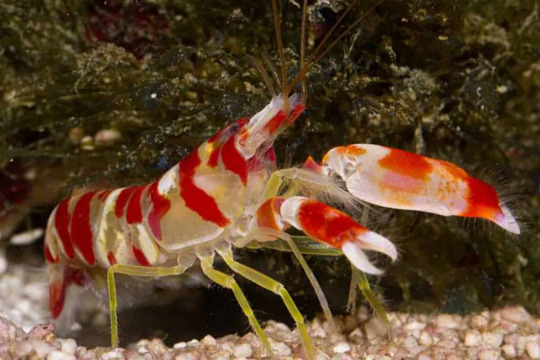
(Image: a pistol shrimp. It is a mostly white shrimp with red stripes. One of its claws is considerably larger than the other. It is standing on gravel and next to some seaweed. End ID)
Pistol shrimp are over 1,000 members of the family Alpheidae, which is part of the infraorder Caridea. This means they are true shrimp, not to be confused with superficially similar animals like brine shrimp, mantis shrimp, tadpole shrimp, and prawns. Yeah, I only recently learned that prawns and shrimp aren't a language difference between British English and American English like chips vs fries. They're not even that closely related. As true shrimp, pistol shrimp have two main body parts: the cephalothorax and abdomen, which are composed of 19 body segments. The abdomen forms a flexible tail with a fin on the end. When startled, the fin can rapidly curl under the body, propelling the shrimp backwards. Like other decapods, there are 10 limbs. The front pair of limbs have evolved into claws used to manipulate objects. The claws are the most distinguishing feature of pistol shrimp. They are asymmetrical, with one growing extremely large, over half the size of the body. The big claw has a modified version of the typical pincer. This pincer has an upper claw that can open up at a right angle. Under the claw is a pocket in the lower pincer, into which water flows. The upper pincer then slams down into this pocket, forcing the water out. The pressure of the pincer closing water in the pocket creates a cavitation bubble that is forced away from the claw at up to 26.8 meters per second. This is enough force to seriously wound small animals and hurt larger ones into leaving the shrimp alone. The cavitation bubbles can reach up to 4,427 degrees C (8,000 F) . For comparison, the surface of the sun is about 1,000 decrees (C) hotter. When the bubble pops, it creates a snapping sound that can reach 218 decibels. For comparison, most gunshots max out at around 170 db. This puts pistol shrimp is the running for the loudest ocean animals, with whales being the other main competitors. If that all sounds like a lot, the whole event happens so fast that the heat doesn't have time to affect much and the noise sounds like a moderately loud snap to us. Adults can snap their claws shut with an acceleration of up to 30 meters per second squared and juveniles can do it up to 20 times faster. The whole process takes less than a millisecond. When the cavitation bubble collapses, it can produce light. This is called sonoluminescence and nobody knows how it happens. If a pistol shrimp loses its large claw, the small claw will grow into a new large one while the missing limb will regenerate into a small claw. Adult pistol shrimp average between 3 and 5 cm long.
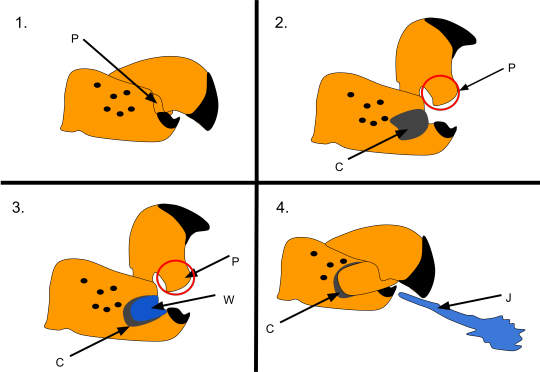
(Image: a drawing showing the process of a pistol shrimp snapping its claw. In the first panel, the claw is closed. In the second, the upper claw opens at a 90 degree angle, revealing a cavity. In the third panel, the cavity fills with water. In the final panel, the claw is closed again and a jet of water is ejected from the claw. End ID. Source: Wikipedia user Carermyers)
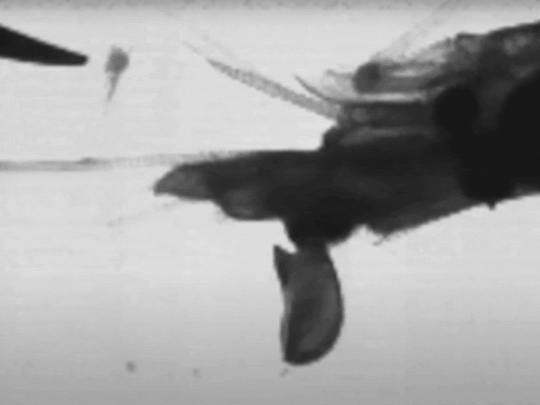
(Gif: black and white, slow-motion video of a pistol shrimp's claw snapping shut and creating a cavitation bubble. End ID. Source)
Pistol shrimp live worldwide, though most species live in tropical or temperate water. There are some cold water species and even freshwater species. Most prefer habitats where they can make burrows and where there are plenty of other animals. Coral reefs, oyster reefs, seagrass beds, mangrove groves are common habitats. Snapping is used for hunting and communication. They typically hide in burrows, waiting for fish or other small animals to pass by. When prey passes, the shrimp will snap to stun or seriously wound the prey, then drag it into the burrow. Some social species actually form eusocial hives with a single queen who produces all offspring. These shrimp are the only known marine eusocial species and all occur within the same genus (Synalpheus), though not every member of that genus is eusocial and eusociality appears to have evolved at least 3 times within that genus. It appears that a reason why only this genus developed eusociality is their larvae do not disperse, instead staying in the same area as the parents. The hives are usually located within sponges. Other social species are not eusocial, but still live together in colonies. Many less social species have formed a symbiotic relationship with gobies. Both species live in burrows, but gobies are bad at digging while the shrimp have poor eyesight. The goby will protect the shrimp while it digs a burrow, then the two live together. They will forage together, with the goby using its superior eyesight to watch for predators and warn the shrimp to get back to the burrow. Pistol shrimp are monogamous, the same pair coming back to mate over and over again (this does not apply to the eusocial species in which only the colony's queen is permitted to mate). The female is only fertile during a short period after molting. The male will stay with the female and protect her during the vulnerable period after mating and some species will remain with each other until the eggs hatch or permanently.
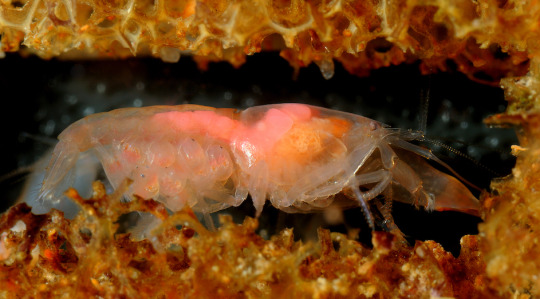
(Image: a eusocial pistol shrimp queen with eggs. Her body is translucent and multiple eggs are attached to her abdomen. The eggs look like translucent balls. The is inside of an orange sponge. End ID)
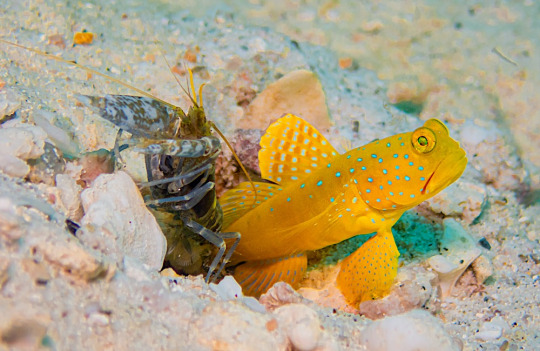
(Image: a pistol shrimp and goby emerging from a burrow in the sand. The shrimp is a mottled green and white. The body is a bright yellow fish covered with blue spots. End ID)
Pistol shrimp are a major source of noise in the places where they live. If you've ever been swimming and can hear repeated cracking noises, that may have been a bunch of pistol shrimp. Some scientists monitor the level of pistol shrimp noises as a method of monitoring the ecosystem. If the noise level drops, that is an indicator that the local ecosystem is suffering. The noise of the shrimps can get so loud that it actually interferes with sonar and forms of underwater communication. During World War II, members of the navy realized that the shrimp disrupted sonar enough to hide submarines, so they started hiding submarines near reefs with lots of the shrimp to keep them from being found by enemy subs. Weirdly not the only small marine animals to mess with submarines. I'll get the the other major one soon. The largest threats to pistol shrimp come from habitat destruction. Some species of pistol shrimp have entered the pet trade. As coral reefs, seagrass beds, and other habitats are destroyed, the shrimp that rely on them will suffer as well.

Yet another time I get to use one of these cards in a post
(Image: the Weird n' Wild Creatures card featuring pistol shrimp. End ID)
#wet beast wednesday#pistol shrimp#snapping shrimp#shrimp#decapod#crustaceans#marine biology#biology#zoology#ecology#animal facts#eusocial#symbiosis#goby#informative#image described
235 notes
·
View notes
Note
I know yall have talked abt human be gones big bug sexuality and stuff, but what about gender? I feel like a lot of bugs have Weird Gender (ants, termites, wasps, bi-gendered moths/butterflies, etc) and I think it’s a cool topic to be discussed. Being a transgender bug sounds awesome

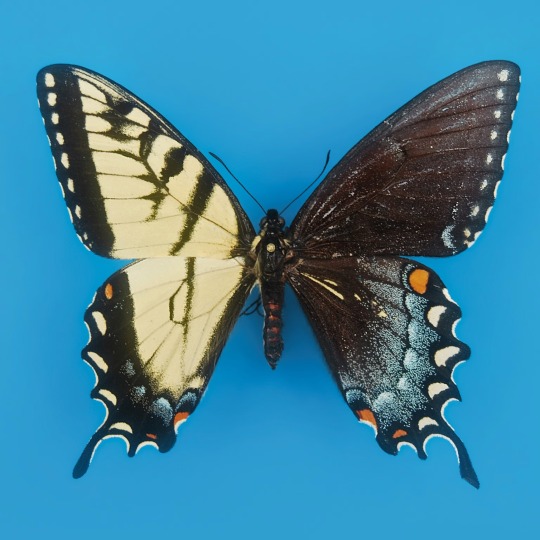
Macrovolute society is heavily influenced by eusocial hymenopterans. As a result, the common macrovolute word for "woman" is actually synonymous with "worker," whereas "prince/drone/male alate" is the same word as "man." (Yes, this caused a great deal of confusion when dealing with the termites and their male workers!)
Queens are seen as something *above* the common female. Not just one who can reproduce (as many worker ants technically can lay eggs that yield males), but one who can reproduce in a way that meaningfully contributes something (by reproducing en masse, living a ridiculously long time, and laying eggs that become useful queens and workers, instead of only largely useless males). Ants and other eusocial insects *do not* view the females of other species as queens--they view them as primitive workers, not yet advanced to totally ceding egg-laying!
The Swarm Mothers are the attempts of the non-eusocial insects to have something like a queen, but they are not the same thing.
As for everything else...well, we'll touch on it in time. ;)
39 notes
·
View notes
Note
Can I pick your brain for ideas lil bit? I'm working on a race of sapient subterranean eusocial arthropods and I can't decide on a biological basis for them. (I've already ruled the three most typical bases for this kind of fantasy guy; ants, wasps and mantids.)
I do however have a firm idea of their indigenous region; a massive biome of networked caves that support jungle-equivalent biodiversity via huge colonies of luminescent microbes that cling to the upper reaches of the caves. These arthropod folk live down here pretty exclusively, but they interact with other subterranean societies. I've also established tangentially that they've domesticated a large (described as 'dog sized') beetle whose larval form is used as livestock cause it produces an edible syrup as a waste product.
anyway I guess the actual question is do you have any ideas for which real world animals I could base these arthropod folk on; or unusual directions I could take the more typical bee/ant/mantis approach.
I don't suppose termites are an option? Something unusual I never see depicted about termites is that they have not only queens, but also kings! They're also unusual in that, unlike wasps, ants and bees (who strictly have female workers), there are also male workers!
If you're looking for more unusual eusocial insects, aphids and thrips are both options.
Like termites, eusocial thrips have both male and female workers. Unlike termites, the male "workers" can breed, however. (Female workers cannot; only special breeding females.) They also have soldiers with big mantis-like claws, which are used for crushing enemy thrips (as well as secreting antifungal compounds)! They all live together in galls (swellings they induce in host plants).
Some images of a species with different galls on different plants:

Some sources:
Eusocial aphids are unusual in that instead of having a single queen or just a few queens, the majority of the population is asexual females giving birth to clones. In some species, there are also (also female, though nonreproductive) soldiers. Some soldiers have turned the central tail spike into a stinger; others have wicked crablike forms like you can see on the right, compared to the more usual reproductive aphids on the left:
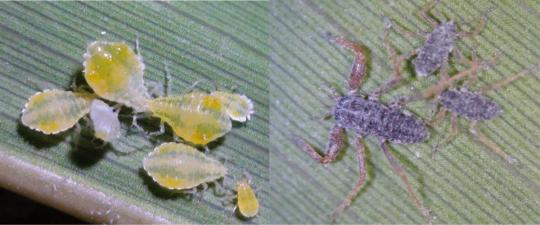
Some eusocial aphids live in galls, like the thrips. Others just live out in the open like usual aphids. Soldiers' duties range from keeping the gall clean (if they live in galls), to killing hoverfly maggots which prey on aphids.
At the end of the year, the aphids lay eggs that turn into winged males and females that breed, yielding the next year's asexual, wingless females again (both soldier and non-soldier).
Some sources:
Hope this helps!
40 notes
·
View notes
Text
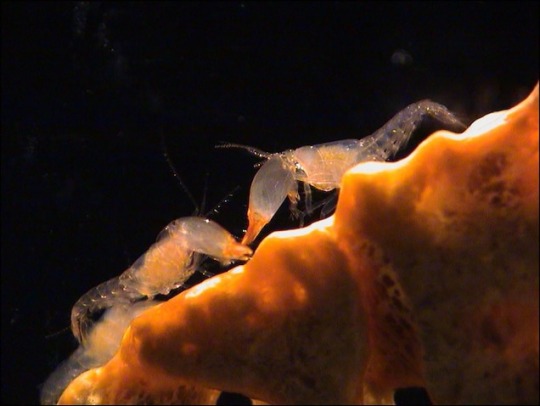



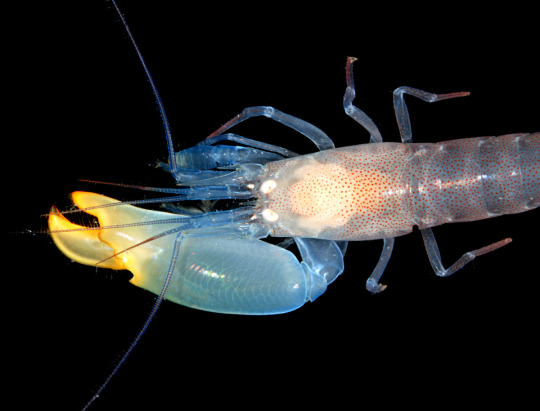
Synalpheus Regalis or Sponge-Dwelling Snapping Shrimp!
On land, we are all familiar with the eusocial behaviors of bees, but did you know that there is one genus of marine creatures that exhibit these same behaviors?
Sponge-dwelling snapping shrimp (aka pistol shrimp) are, according to Nat Geo, the bees of the sea! These tiny shrimp host the inside of sea sponges and live in colonies of about 300 members. The queen will reproduce while the eggs/babies are cared for by the colony. Guard shrimp also protect the queen and the colony from predators. This altruistic behavior exhibited by these shrimp is a strange and beautiful act that is continually being studied by scientists!
#shrimp#snapping shrimp#pistol shrimp#colony#sea sponge#beauty under the waves#sea#ocean#underwater#marine wildlife#ocean life#saltwater#marine creatures#sea creatures#sealife#animal#marine animal#marine biology#eusocial
385 notes
·
View notes
Photo
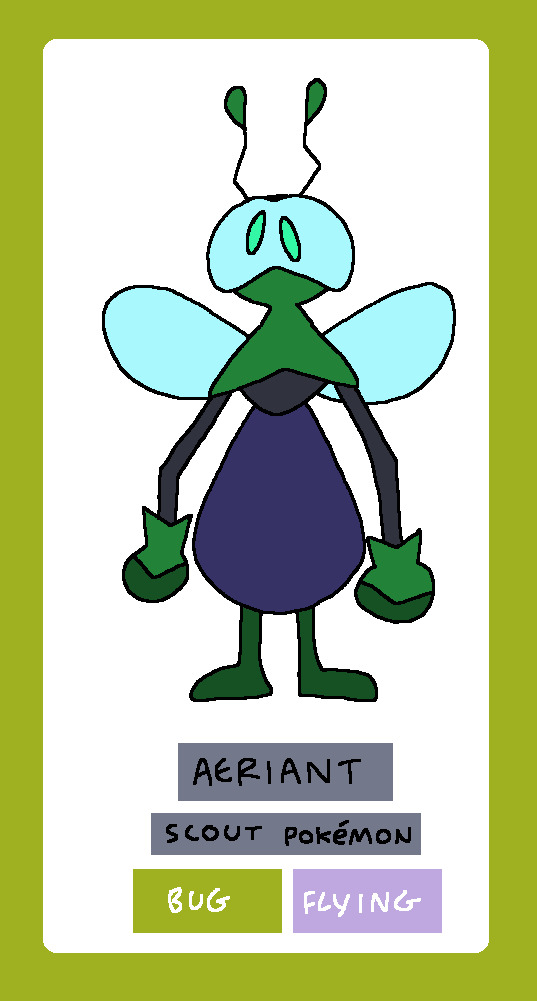
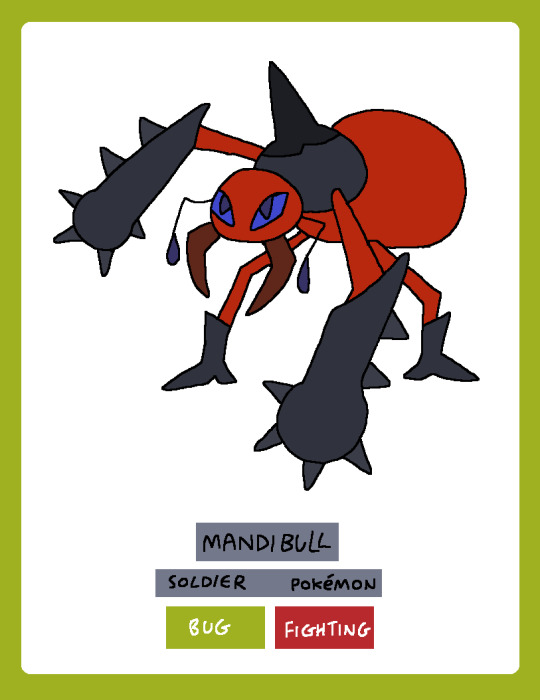
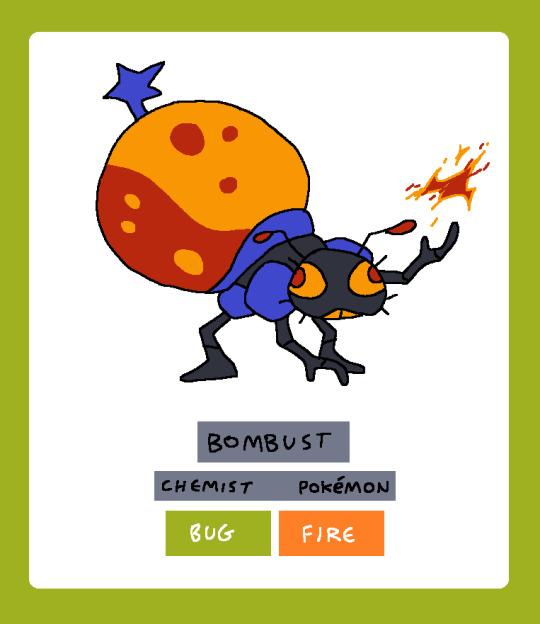

#033 - Aeriant
#034 - Mandibull
#035 - Bombust
#036 - Cordyceph
ant pokemon! they don’t evolve from each other but appear in double (or triple?) battles in the wild
#fakemon#pokemon#bug type#flying type#fire type#fighting type#psychic type#ants#ant#insect#eusocial#flying ant#fire ant#honeypot ant#bulldog ant#army ant#ant queen#cordyceps
126 notes
·
View notes
Text
"How do ants decide what they want to do?"
"How do ants decide what they want to do?"
This is a seemingly simple question, but it has deep implications. How do ants decide to forage, care for young, feed the queen, attack the enemy, repair the nest... how do they pick a task? How often do they reevaluate?
However ants may choose it must take into account the status and needs of the entire colony. But, ants have very small brains. They probably only know a little bit about the world around them, so the needs of the colony must be inferred from sparse and local (to the ant) information.
In species with polymorphism the decision must take into account the size of the ant and what tasks she is best suited for. A solider ant will try to care for the young if no one else is doing that job. But, more often she will sleep or patrol and leave the nurse work it to small ants.
You may see a tiny nurse ant trying to help kill a delicious cricket ... but mostly she would rather feed the queen, or the babies. All ants can try to do all tasks ... with the exception of laying eggs, only the queen can do that task.*
*some species have gamergates, workers who become egg laying queens when the queen dies, so even egg laying can be a shared task. However, the danger of the colony wasting too much energy in fights over who gets to lay is averted in most cases by having a single queen.
#ant thoughts#ants#antposting#hymenoptera#gamergate#eusocial#evolution#insect intelligence#bug brains
22 notes
·
View notes
Text
Hello, meet my current Fascination: Synalpheus regalis, the Eusocial Shrimp Queen with a whole ass GUNARM. She lives in a big symbiotic sponge(see fig. 1) with her many infertile adult children and their MASSIVE GUNARMS that are useful for both snappy, click based communication and to create cavitation bubbles which boil at the literal heat of the surface of the sun.
Recent studies show that the emergence of Eusociality in these shrimp seems to have been rapidly driven in a short window of time by a mysterious flurry of motherfuckin Transposon activity!? Fuck me if I don't even think I can begin to grasp the full implications of transposons being able to drive evolution on short time scales, let alone change the entire social/reproductive strategy for a whole species complex in like a handful of generations.
Seriously, typein: 'Synalpheus regalis "Transposons"' into Google Scholar if you need further convincing that the fundamental stuff of reality is information and not the matter it underlies. Its wack as all hell I tell you. Theres like 6 people studying these out of Columbia and I have a strange research crush them and their weird Jesuit friends in Seattle.


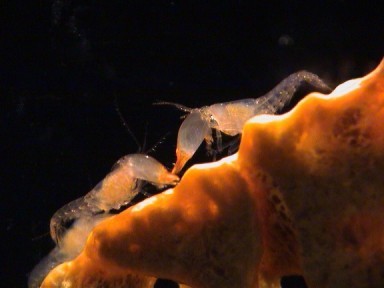
4 notes
·
View notes
Photo

Agrégaire & Conjectif #individual #individuality #group #collectivity #agent #entity #agentivity #coactive #gregarious #cooperation #intersubjectivity #eusocial #collaboration #transmission #influence #vector #mimetic #conformity #adhesion #emergence #holism #system #integralism #incremental #blob #spectrum #structure #computation #network #modul https://www.instagram.com/p/CplGoF8NG5L/?igshid=NGJjMDIxMWI=
#individual#individuality#group#collectivity#agent#entity#agentivity#coactive#gregarious#cooperation#intersubjectivity#eusocial#collaboration#transmission#influence#vector#mimetic#conformity#adhesion#emergence#holism#system#integralism#incremental#blob#spectrum#structure#computation#network#modul
1 note
·
View note
Text
Reblogs = sample size etc etc
I'm aiming for informative, not funny - any context on how long is too long to bother watching would be nice as well so feel free to share in the tags
#youtube#twitch#scicomm#videos#video essays#my art#science#(context: im thinking about making a youtube channel again since all the informative videos about hiveminds are less than 5 minutes long)#(you cant even get into the drivers of eusociality in 5 minutes cmon)#but also i know i like my videos much longer than anyone else i know sooo
429 notes
·
View notes
Text
i love parasites so much. they are like the evolutionary biological equivalent of those minerals people find in the earth that are fantastical shapes and colors in terms of awe factor to me
71 notes
·
View notes
Text
Either tumblr's suggestion algorithm is so accurate and aggressive that they've pegged my interests immediately and are recommending content regarding Disco Elysium and Ultrakill and nothing else directly off the bat or my specific breed of autism is being spread in the water supply and all of you are infected
#disco elysium#ultrakill#I am patient zero for a disease that turns humans into a eusocial hivemind whose sole purpose is consuming specific pieces of content#long live the BeeMan colony
21 notes
·
View notes
Text

my stab at 'phantom dimensional rats'. based on real life aphids, which ants have been observed protecting and 'milking' for their sugary secretions. phantom dimension rats spawn candy, so phantoms (notoriously sweet-toothed) love them.
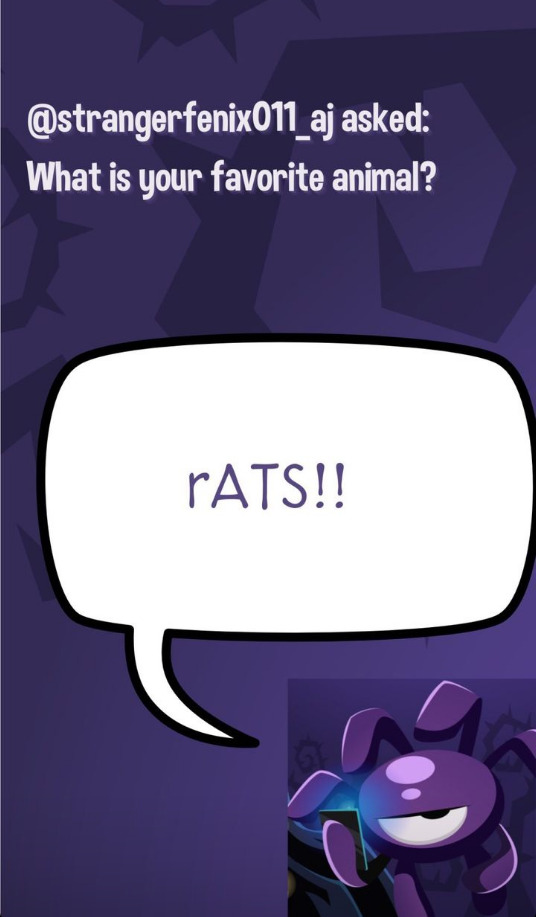

#talks#theres no particular reason my phantom lore is ants based i think phantoms are more just loose eusocial insectlike but i#happen to like ants so thats what youre getting.#animal jam
33 notes
·
View notes
Note
Are the Schistocerca gregaria, Locusta migratoria, Nomadacris succincta, and Anacridium sp grasshoppers/locusts still around? And, can they still become gregarious?
Oddly specific question, I was just thinking about how crazy yellow ants are the only eusocial insects in where we are in the story. But locusts are….weird.
(p.2) Well I guess locusts aren’t really *eusocial* as they don’t have a social hierarchy like ants do, but gregarious behavior still seems like a threat.
On the contrary, the ants view the grasshoppers the least of a threat of all macrovolutes! In the notes for episode 6, you can read a little on how Grasshopper Swarm is regarded as a non-Swarm, because the grasshoppers believe gathering in large numbers is bad luck...because of the locusts, yes! Locusts are certain species of grasshoppers which form devastating swarms during periods of starvation. As macrovolutes, all grasshoppers vow never to form groups that large, under any circumstances. They're anarchists, and don't fully understand how laws work when they are among insects that belong to Swarms.
And there's nothing the ants like better than a big, fat, lonely insect that has a poor grasp on laws. It wouldn't be an exaggeration to say the ants view the grasshoppers as sort of free range cattle, for when stocks of isopods and millipedes are low. Or, even when they're not.
In real life, gregarious behavior is not at all uncommon for insects, though true sociality is. You can very often find insects of the same species gathered around a food source (aphids, other true bugs, flies, roaches, etc.), or just clustered together to hibernate (e.g. ladybugs). The ants in HBG do not regard this as a threat, and in fact, the other macrovolutes were pressured to form *some* kind of social structure to convince the ants they were worth dealing with at all!
15 notes
·
View notes
Text
DARPA asked for proposals for insect-based AIs. Bug furries/monsterfuckers and robofuckers need to unite to completely sexualize this concept before they make it work
#CMON! YOU CAN DO IT!!#I'VE SEEN WHAT YOU PEOPLE DO WITH MILITARY ROBOTS!#AND I'VE SEEN WHAT YOU PEOPLE DO WITH EUSOCIAL INSECTS!#andi'dliketoseemoreplease#robotfucker#robophilia#monsterfucker#shitpost#geeeeeeeeh i have so much on my plate i dont wanna do it myself....
19 notes
·
View notes
Text
More types of bugs ought to be eusocial I think. It would be very cool.
I want to see what it would be like for mosquitos to try to store blood like bees store honey. I want to see swarms of lightningbugs as they leave to make a new nest. I want to see what a queen butterfly looks like.
12 notes
·
View notes
Text
Watching that one David Attenborough documentary, The Green Planet, and I really need to research leafcutter ants more because they feel like good [species that later became the Jem'Hadar] inspo
They farm fungi! And they receive chemical signals from the fungi that tell them what kind of leaves to gather to feed it!
That feels so much like what I had in mind for [species name currently redacted for Challengers Spoiler Reasons™] and their symbiotic relationship with the fungi that later became the basis for ketracel-white. I kind of love it.
(if you're wondering where "proto-Jem'Hadar were a eusocial species" comes from, I first wrote about it here)
8 notes
·
View notes